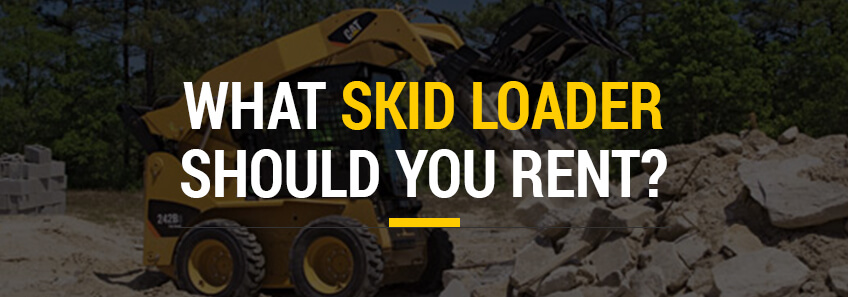
Skid loaders are among the most versatile pieces of equipment on any job site. Renting this equipment can make your construction projects more efficient, productive and profitable.
Skid loaders are incredibly popular. Before renting a skid loader, do your homework. There are many skid loader sizes and designs available, as well as an array of skid loader attachments. Start investigating your rental options by asking some questions about your project requirements. Then look at the different types of skid loaders available for rent to determine which best suits your needs.
Jump to Section:
- Job Site Size Restrictions
- What Materials Need Moved
- Job Site Conditions
- How High Do I Need to Reach
- How Far Do I Need to Travel?
- What Attachments Do I Need?
- What Skid Loader Should I Rent?
- How To Rent A Skid Laoder
What Job Site Equipment Size Restrictions Do I Have?
Fit your skid loader size to your job site. Operating large equipment in a tight space is impractical, if not impossible. It’s also not efficient to use small equipment when you have plenty of room to get more work done in less time with a full-sized loader. In general, the industry divides skid loaders into these three categories:
- Small skid loaders: These are skid steer loaders, compact track loaders and mini loaders with a maximum 1,750 rated operating capacity (ROC) and with engines less than 50 horsepower (HP). These are highly maneuverable and have the lightest load footprint. Small skid loaders work well in tight places, such as landscaping projects and interior demolitions.
- Medium skid loaders: The most popular skid loaders are the mid-sized class. They have a ROC between 1,750 and 2,200 pounds with engines rated from 50 to 70 HP. If you have sufficient room, a mid-sized loader may be a perfect fit due to its increased power and larger bucket capacity.
- Large skid loaders: There’s no substitute for a large skid loader if you’re unrestricted by job site size or terrain. Large loaders exceed 2,200 ROC pounds and have engine horsepower ratings above 70. Large skid loaders can also use work attachments and have the lifting strength to fill trucks or bins.
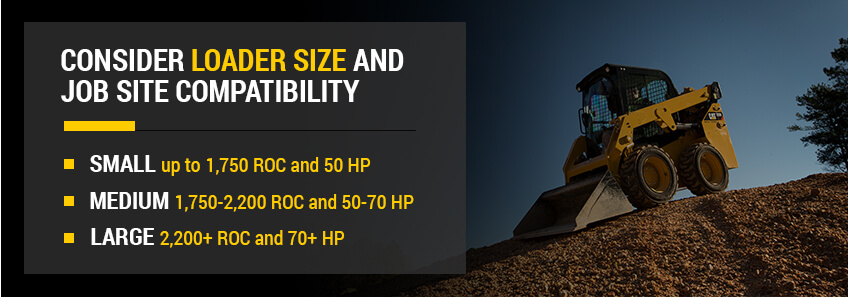
What Material Will I Load or Move?
Another important question when selecting a skid loader is what material you’ll be moving or lifting. This is a critical factor in determining equipment size and configuration. Renting a skid steer or multi terrain loader that’s undersized will be counter-productive.
Because skid loaders are so versatile, they can be used to load or move a huge range of materials. You may be renting a skid steer to move material around a backyard landscaping job site where the lifting is light and low. You might also want to rent a skid loader to load and unload heavy material from trucks or containers. Either way, it’s critical to match the equipment to the task.
Matching your loader to your material takes careful consideration and familiarity with your workplace. Consider the weight, density and porosity of your materials.
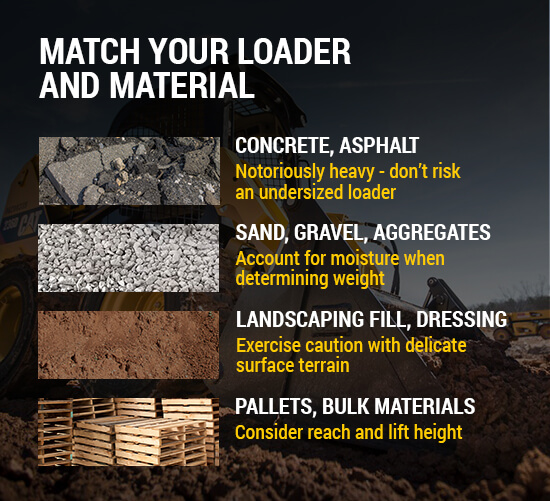
Heavy materials require plenty of power to move them. For heavy weights, use large equipment. Bulky materials can be lightweight, but you may want large equipment to move them efficiently. Here are typical job site materials and their suggested equipment capacities:
- Sand, gravel and aggregates: Construction materials like gravel, sand and stone aggregates are probably the most common commodities moved by the majority of skid loaders. Depending on the exact material, their weight can vary greatly. Moisture content is an important factor. As a rule-of-thumb, rent a loader with more lifting capacity that you’ll require.
- Concrete and asphalt: These materials can be notoriously heavy. Wet concrete mixes will test the power capacity of the largest loaders. Asphalt also puts significant strain on a loader. It’s a serious mistake to choose an undersized loader if you’re moving asphalt or concrete.
- Landscaping fill and dressing: Landscape work usually presents material moving challenges. Most materials you’ll encounter in landscaping tend to be lighter and bulkier than substances moved on other sites. It’s not necessary to overpower your loader for moving landscape fill or dressing. Find a balance between an equipment weight that doesn’t damage your surface and an overall capacity that still gives you economic efficiency.
- Pallets and bulk materials: Moving pallets and bulk materials requires the right skid loader selection. Reach and lift height are important considerations as most loader pallets go on and off truck beds. Bulky materials like lumber lifts or construction components need equipment that has enough lift height and reach extension to perform safely and efficiently.
What Are My Job Site Conditions?
Conditions to consider can include the terrain where you’ll be running your skid loader, the slope of the ground or weather-related factors like heavy rain and ice or snow.
Ground surfaces range from soft to hard and tough to delicate. For instance, you might have job site conditions where most of your work will be on hard ground like compact gravel, concrete or asphalt. You might also have soft surfaces like mud, sand or even a finished lawn.
Slopes and angled job site conditions require operator care and a skid loader that’s designed to perform on unlevel ground. Slopes usually offer traction problems, and this is where a compact track loader or multi terrain loader will safely outperform wheeled equipment in most cases.
Weather is an inescapable and important factor in outdoor job sites. In fair and dry climates, most loaders perform without unusual issues, but ice and snow present a unique challenge. Here you’ll find that track equipment is your best choice.
Job site conditions also refer to the area and workplace parameters. This will dictate your equipment size more than your loader’s power. Here are typical site conditions you’ll encounter and suggestions about what rental loader to select:
- Hard surfaces: Pavement and concrete work best with wheeled skid loaders. On hard surfaces, you have a lot of options regarding equipment size. You’re not restricted by equipment weight, and it’s best to select equipment that’s slightly overbuilt for your average requirements.
- Soft surfaces: Conditions like wet sand, snow and grassy areas are challenging for wheeled skid steers. Soft surfaces are all about weight distribution or ground pressure that your loader exerts. For most soft surfaces, it’s best to rent tracked equipment that isn’t any heavier in overall weight than necessary.
- Sloped surfaces: It pays to be extra careful if you’re operating on sloped surfaces. It’s far safer and more productive to use a compact track loader or a multi terrain loader than a wheeled skid steer. Again, it’s about weight distribution as well as the equipment’s center of gravity point and traction ability.
- Slippery surfaces: Here is where compact track loaders and multi terrain loaders really outperform wheeled skid steers. The gripping surface area provided by rubber or steel tracks offers more stability and traction than tires. If you’re on ice, snow, mud or other slippery surfaces, consider renting a loader with tracks.
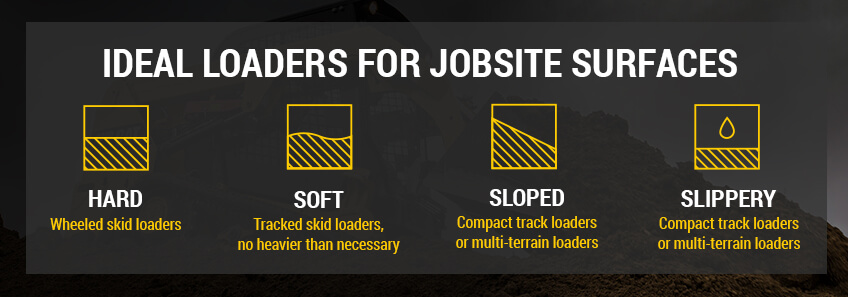
How High Do I Need to Reach?
Height and reach are actually two different parameters when you’re talking skid loaders. Height refers to the vertical lift the rental loader is capable of. Reach means how far away from the loader’s frame that the bucket, forks or other work tool attachment can move.
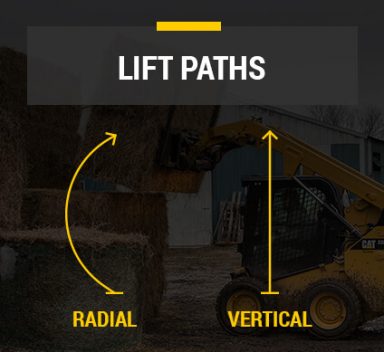 Height, or vertical lift, is especially important when loading trucks or unloading pallets. As a rule-of-thumb, you’ll want a loader that has 2 feet more lift capacity that the upper edge of your container. For example, if your truck box is 6 feet above ground level, then you’ll want to rent a loader that has an 8-foot vertical lift.
Height, or vertical lift, is especially important when loading trucks or unloading pallets. As a rule-of-thumb, you’ll want a loader that has 2 feet more lift capacity that the upper edge of your container. For example, if your truck box is 6 feet above ground level, then you’ll want to rent a loader that has an 8-foot vertical lift.
Reach affects loader performance at ground level where you’re pushing grade material. It also matters when you’re reaching onto a truck deck to place or retrieve materials.
Most skid loaders use one of two types of lift paths — radial or vertical. The difference appears when the bucket is more than 3 feet off the ground.
- Radial lift path: Radial lift designs allow your loader’s arm an outward swing before it reaches its maximum height. Most radial lift path loaders provide 80% of the total lift motion in a forward reach. This lift path design works best when you’re renting a loader for general ground work, digging and grading.
- Vertical lift path: Vertical lift designs allow your loader’s arm to move straight up and down and then outward at its peak. There’s little, if, any, forward reach until the top when the bucket or forks suddenly extend or reach out. Vertical lift path loaders are ideal for working at height like loading dump trucks or unloading materials from decks.
How Far Do I Need to Travel?
Travel distance is another serious factor affecting your rental loader choice. You can lose a lot of time if you select a loader that’s not fast enough to move your materials about your site. This is the main issue when you’re considering wheels vs. tracks in your skid loader decisions.
There’s a trade-off when it comes to loader travel. If distance covering is a prime concern, then you’ll want a loader with a high-speed capacity. You’re going to get that with a rubber-tired or wheeled loader more so than you’ll find with tracked equipment.
Wheeled skid steers are built more for speed than for traction and stability. On a level site with hard ground, it’s hard to beat wheels when it comes to zipping about and moving material. If you’re picking from piles and spreading over a large area, then your best rental option is a wheel-equipped skid steer.
However, if your travel distance is short, and you’re in a tight place, the wheels may not suit you best. Stability and traction may be more important than speedy service. Ground preservation might also be a prime factor, which you’re going to get more with tracks compared to tires.
The balance between travel distance and work performance is going to be unique to your site and your particular project. On some sites, you’ll be better off with faster, wheeled equipment. On others, slower but steadier tracks will outperform tires. Here are general travel considerations to weigh when you’re renting skid loaders:
- Long travel distances: Travel time can significantly cut into job site performance. If your material moves involve repeated long-distance runs, then a wheeled loader will likely be best as long as you don’t face sloped, slippery or sensitive ground.
- Medium travel distances: This can be a 50/50 rental decision. You might have repeated trips over relatively short spaces where travel time isn’t a huge factor. If so, take ground conditions and traction into account over any speed concerns.
- Short travel distances: If travel periods and run time isn’t a performance issue, then you should select your skid loader design on factors such as physical size, equipment weight and power capacity. Your propulsion system should match your site conditions and project purpose more so than any travel efficiency you might encounter.
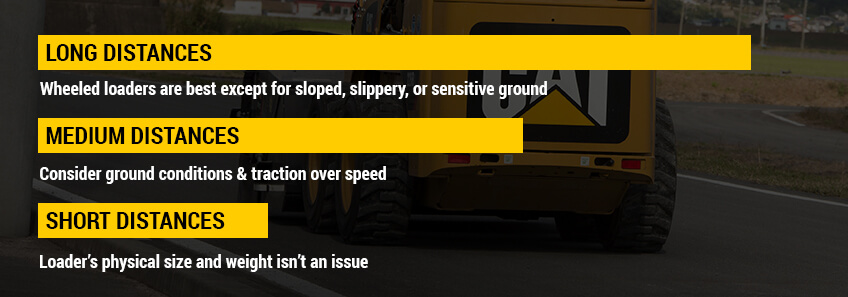
What Attachments Do I Need?
Work tool attachments can be the deal-breaker when it comes to your rental skid loader choice. Work tools are one of the key reasons that all types of skid loaders are so popular with construction companies and contractors. The variety of work tools you can rent with your skid loader let you explore limitless options of functionality.
Make sure your work tool selection is compatible with the specific loader you’re selecting. Additionally, your skid loader has to have sufficient power to operate your work tools. A skid loader needs to power itself and operate an attachment. Some work tool attachments draw a lot of power, and you have to ensure your skid loader’s engine and hydraulic systems can run your rented attachments.
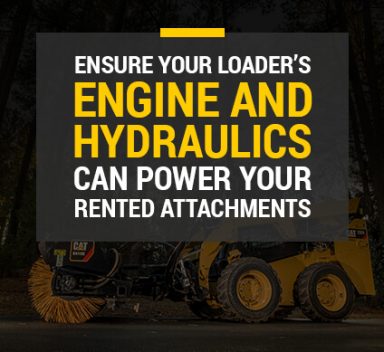 There are two important factors to assess when choosing a skid loader to operate work tool attachments — the engine and the hydraulics.
There are two important factors to assess when choosing a skid loader to operate work tool attachments — the engine and the hydraulics.
- Skid loader engines: Most skid loaders operate on diesel engines. Engines are rated by horsepower and torque. Some mini skid steers are electric, but they typically have horsepower ratings as well.
- Skid loader hydraulics: Your rental loader has to have sufficient power to pressurize its hydraulic system high enough to meet minimum tool capacity requirements. Smaller loaders with standard hydraulic systems may be weak with attachments. If you plan on operating attachments, make sure the skid loader you’re looking at has an auxiliary hydraulic system with a high-flow and high-pressure capacity.
The beauty of working with a skid loader is its incredible adaptability. Whether you rent a rubber-tired skid steer, a compact track loader or a multi terrain loader, you can turn it from a bucket bailer to a brush cutter in no time. You can also reconfigure your skid loader into a compactor, pavement ripper or post-hole auger. Here are some of the other handy work tool attachments available to rent with your skid loader:
- Aerators
- Brooms
- Forks
- Graders
- Grapples
- Hammers
- Pulverizers
- Overseeders
- Rockhounds
- Stump grinders
- Tillers and trenchers
What Skid Loader Should I Rent?
Deciding what skid loader to rent depends on your job site restrictions and conditions, what loads you’ll handle or move, your reach and your lift height requirements as well as what work tool attachments you plan to use with it. That’s a lot of factors, but your decision really comes down to the equipment’s physical size, its engine and hydraulic power and its propulsion system. Here are your three main skid loader rental selections and the models you’ll find in each.
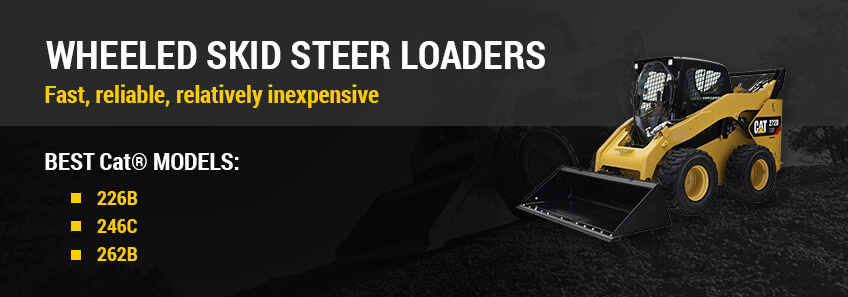
Rubber-Tired or Wheeled Skid Steer Loaders
Wheeled skid steer loaders mounted on rubber tires remain the most popular choice for most rental applications. That’s because they’re fast, reliable and relatively inexpensive. They’re also capable of operating the complete work tool rental line provided the equipment has enough power. These are your best Cat® skid steer models:
- 226B: This is the smallest Cat skid steer. It has a ROC rating of 1,500 pounds and has a 57 HP engine.
- 246C: For a mid-sized Cat skid steer, choose the 246C. It has a 73 HP engine and can lift 2,150 pounds.
- 262B: If you want powerful equipment to move materials and run tools, the 262B is outstanding. Its ROC is 2,700 pounds and it’s powered with 78 HP.
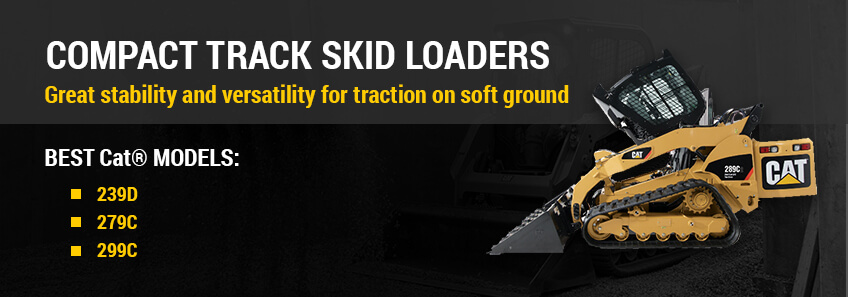
Compact Track Skid Loaders
For your best traction on soft ground, compact track skid loaders offer you great stability and versatility. Compact track loaders have excellent weight distribution, which translates to minimal ground disturbance. If you’re looking for top-quality Cat compact track loaders, here are three best choices:
- 239D: This is a light-weight Cat compact track loader for tight space work. It has a 66.5 HP diesel engine with a 2,050 ROC.
- 279C: For mid-sized equipment, take a look at the Cat 279C. It’s ROC is 3,200, and it has 84 HP.
- 299C: The big Cat compact track loader gives you lots of traction and auxiliary hydraulic power. The engine rates at 94 HP and the RCO stands at 4,150 pounds.
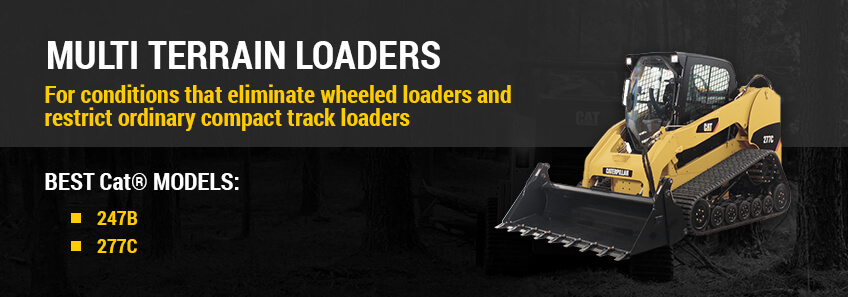
Multi Terrain Loaders
Multi terrain loaders look like compact track loaders, but they have an entirely different undercarriage, suspension and track design. This allows multi terrain loaders to operate in many conditions that would eliminate wheeled loaders and restrict an ordinary compact track loader. Here are two top multi terrain Cat skid loaders available to rent:
- 247B: For a smaller unit, you can’t go wrong with the Cat 247B. It has 57 HP and a 1,950-pound ROC.
- 277C: This is the largest Cat multi terrain skid loader. The ROC is 3,200 pounds, and it’s powered by an 82 HP engine.
Who Should I Contact to Rent a Skid Loader?
This is the easiest decision you’ll make when you’re looking into renting a skid steer loader or any of the wide assortment of work tool attachments. It even applies to renting other equipment for on your job site. You should contact MacAllister Rentals, of course.
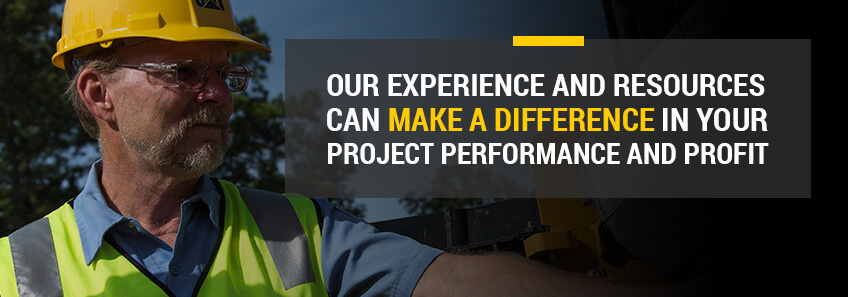
With locations throughout Indiana and Michigan’s lower peninsula, we’re the leading heavy equipment supplier of rentals. We have the experienced staff and the resource range to make that difference in your project performance and profit. Consider the cutting-edge benefits MacAllister Rentals offers you:
- In-depth product knowledge
- First-class service
- Trustworthy and understanding
- Right equipment at hand
- Value-added essentials
For more information on renting a skid loader, contact MacAllister Rentals today at (877) 700-1945 or contact us online.
